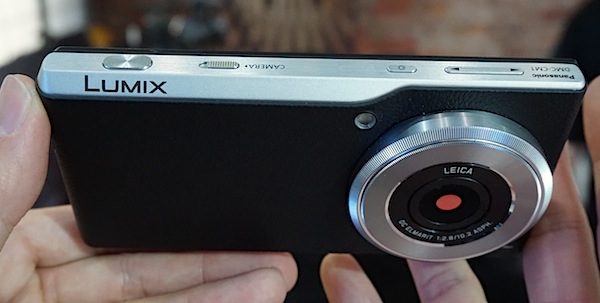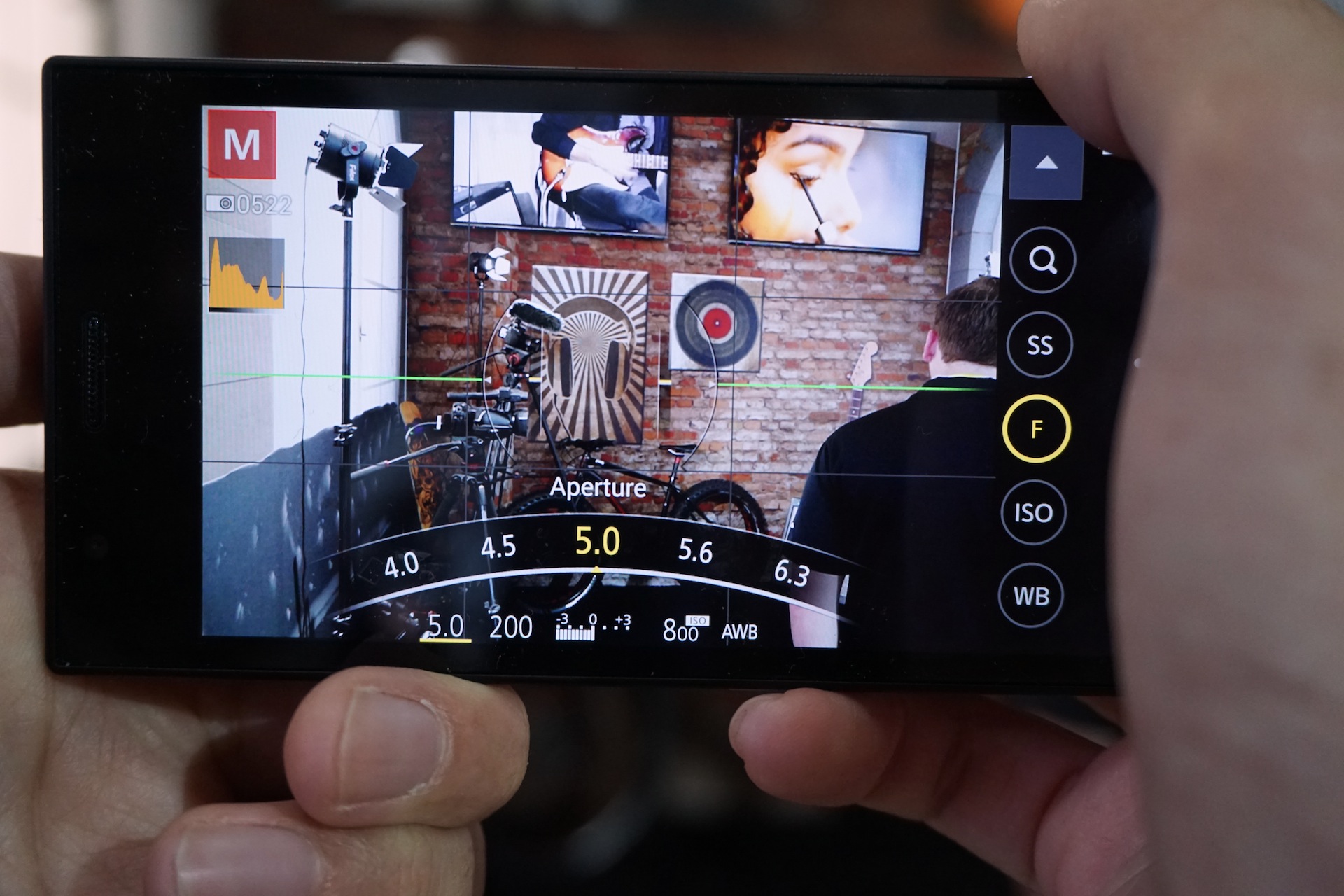Exclusive Tests: Panasonic CM1 Is Real Camera, and Phone
Full-function camera plus phone combined in one slim device offers advanced controls and features, plus great images in our initial tests.

It's a shame the word "cameraphone" is already taken — to mean simply any camera on any phone. Otherwise it would be the best word for Panasonic's new Lumix DMC-CM1: a full-fledged, 20-megapixel camera and an Android (4.4 KitKat) smartphone in one device that's slim enough for a back pocket.
Having released the Lumix CM1 in Europe last month, Panasonic announced its plans to bring the camera/phone to the U.S. this year at CES 2015. Panasonic hopes to sign deals with carriers to offer the phone subsidized on contract. Unlocked without a subsidy, it will run about $1,000, the company reckons. Panasonic handed me the CM1 for a few hours to put it through its paces. I didn't have enough time to call this a full review; but it's a lot more detailed than a quick hands-on.
We'll update this to a formal review as soon as we can get more time with the camera.
MORE: Best Phone Cameras
Overall, I'm impressed. Photos I took with the camera's giant (for a smartphone) 1-inch CMOS sensor are more detailed, and less troubled by graininess, than those from even stellar phone cameras like the iPhone 6/6 Plus, Sony Xperia Z3 and Samsung Galaxy S5 and Note 4. The advantage really shows up in low light. It's not hard to guess why the CM1 kicks butt: It has genuine camera features in the sensor and lens that are extremely rare or nonexistent in smartphones.
Design: pocket-wonder
A camera like the Lumix CM1 shouldn't exist, based on the laws of physics and how much Panasonic has managed to cram inside. The black-and-silver main slab is the size of a typical Android phone — with a 4.7-inch screen and a mere 0.6-inch thickness, growing to 0.8 inches with the lens mechanism. (Remember, there's a full-on camera inside.) It's not the first product of its kind: Samsung's Galaxy S4 Zoom (see review) and Galaxy K Zoom have the same idea. But the former is a bit too much of a camera, in terms of size. And the latter is too much a phone, in terms of ergonomics.

Along the top edge of the phone, next to the power and volume buttons, is a sliding switch that activates the camera and a shutter-release button — no need to tap icons and navigate onscreen menus to start shooting. The lens mechanism is at the right side of the camera, when facing you. It's surrounded by a low, metal control ring, that you can turn to make various adjustments — including white balance, ISO light sensitivity, shutter speed, aperture and shooting mode (Auto, Aperture priority, Manual, etc.).
You read that right.

The 28mm-equivalent prime Leica lens, which rises up about a quarter inch when you turn the camera on, features an adjustable aperture (f/2.8-f/11) providing the ability to operate the camera in full manual mode. That's extremely rare for phone cameras — which almost exclusively have a fixed-size aperture.
MORE: HTC Desire Eye Review: Super Selfie Camera

Somehow Panasonic got this superslim lens system to spread an image over a 1-inch sensor. You'd expect that size chip in a bigger camera with a bigger lens, such as the Nikon 1 or Samsung NX mini lines of mirrorless, interchangeable-lens models or in high-end bridge cameras like the $800 Sony RX100 III or $700 Canon PowerShot G7 X (see review). For more perspective: The sensor in the phenomenal iPhone 6/6 Plus camera is just 15 percent the size of the Panasonic CM1's.
Image quality: fine detail and little noise
Those specs really do matter, as the photos show. Shooting at ISO 1600, which is high for even some entry-level DSLRs, the Lumix CM1 captured images that were virtually free of noise (graininess) and thus very detailed even at 100 percent magnification (which is enormous for a 20MP photo). Such high ISO allowed me the fast shutter speed to capture a guitar player at Panasonic's booth and nearly freeze the motion of is strumming fingers and bobbing head.
[You can click on all the images to get a larger, though not full-size version.]
Here's the photo reduced to about 2 megapixels. (click this image, as with all the others, to expand.)

And here is a section of the photo at 100 percent magnification.

The CM1 also captured clean detail and nice color in this photo of my co-worker Jill under so-so lighting at the Las Vegas Convention Center.

And it shows the hues and textures to convey the yumminess of salad I had for lunch.

The CM1's manual controls allowed me to get creative more easily than I could with another smartphone. Any camera in an auto or semi-auto mode would fiercely resist efforts to create this silhouetted image of palm trees behind a brilliant Las Vegas sun. With control not only of shutter speed but also of a real, physical aperture, I could stop down the camera to get this shadowy exposure that any auto mode would consider way too dark.

Aperture control also let me play with depth of field, as in this close-up of a strawberry from my salad shot at the largest aperture, f/2.8, showing the background blurred out. A larger sensor is also key to achieving shallow depth of field. On a normal camera phone, the tiny sensor keeps everything sharp regardless of the aperture used. (Don't ask me to explain the physics here.)

Speed: not so much
The Lumix CM1, at least in the form I saw it, is not really an action camera. It focuses tolerably fast, given its run-of-the-mill contrast detection autofocus. But it's no match for the nearly instant phase-detection (aka focus pixel) AF system in the iPhone 6 and rivals such as the Samsung Galaxy S5 and Note 4. With the CM1, you'll likely get a sharp photo of someone who remains at about the same distance from you, thanks in part to the camera's solid face-detection AF. But running kids would probably be too much for it.
MORE: Why Autofocus is the New Megapixel
The CM1's great burst mode might boost your chance of getting a crisp shot, however, as you simply have more options.
Video: slow and a little wobbly
The Lumix CM1 captures both HD and ultra HD video, but feebly. HD video tops out at 1080p and just 30fps, which can make any movements look a bit jerky. A 60fps is pretty common in smartphones today; and many do 120fps and even 240fps for slo-mo playback. The CM1 also records in ultra HD, but at a languid 15fps that would yield a very high-res nickelodeon movie.
Given the technical limitations, the CM1 performed OK in video. My footage of the guitar player was generally pleasant to watch, except for an occasional wobbly look. Yes, I shook the camera a bit, but that's what happens when people shoot video with cellphones. Audio from the built-in stereo mics sounds pretty full.
(As always, your bandwidth, and our video compression, may yield lower quality than the original.)
In this clip of, um brand ambassadors, at CES, the movement looks more fluid, and the exposure is pretty accurate given the low and changing lighting. Audio is painful, but that could be because the blaring, thumping music of the show floor simply overwhelmed the poor little stereo mics.
Still a phone in some respects
While the CM1 is more camera than any other cameraphone I've used, it still has some of those phone limitations. The giant screen is wonderful, but it's a big target for clumsy fingers. I often bumped the screen and changed settings or dug into submenus I had no intention of exploring. I love the manual control ring around the lens, but it's so thin that my fingers often missed it. And it's rather hard to hold the camera steady when you're twisting the ring with one of you hands.
If the CM1 were to cost as much as a regular smartphone, it would be a no-brainer for many photographers. But at several hundred dollars more, it might make sense to get a regular subsidized phone -- even a top-end one like the iPhone 6 -- and use the savings to buy a solid bridge camera like the Sony RX100 III (see review) or Canon G7 X. Both of these cameras can squeeze into a pocket, albeit not the same pocket as your phone.
But if you hate lugging gear as much as you love taking photos, the CM1 could be quite compelling. Even better, it raises the bar for all future smartphone cameras.
- Face-Off: Smartphone vs. Mirrorless Camera
- DSLR vs. Mirrorless Cameras: Which Is Better for You?
- iPhone 6 Camera Quirks – and How to Fix Them
Senior editor Sean Captain wants a DSLR that fits in his pocket. Follow him @seancaptainand on flicker at Sergiocapitano. Follow us @tomsguide, on Facebook and on Google+.
Sign up to get the BEST of Tom's Guide direct to your inbox.
Get instant access to breaking news, the hottest reviews, great deals and helpful tips.
Sean Captain is a freelance technology and science writer, editor and photographer. At Tom's Guide, he has reviewed cameras, including most of Sony's Alpha A6000-series mirrorless cameras, as well as other photography-related content. He has also written for Fast Company, The New York Times, The Wall Street Journal, and Wired.
-
rexter Like the Samsung the Samsung galaxy camera, it'll be unoriginal to call it a camera phone; camera on android or camera on kitkat is much better.Reply
